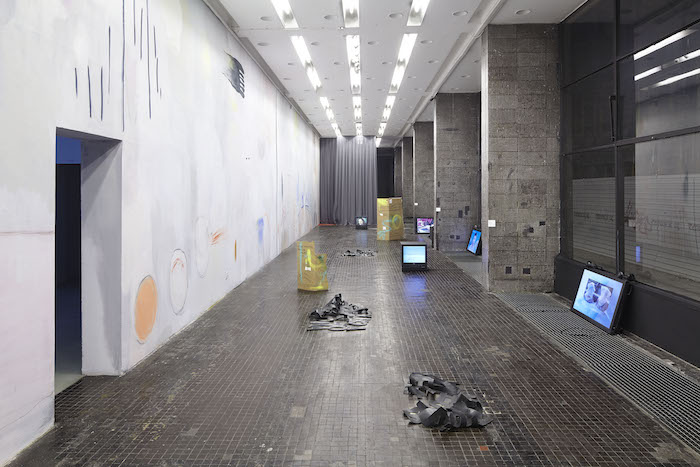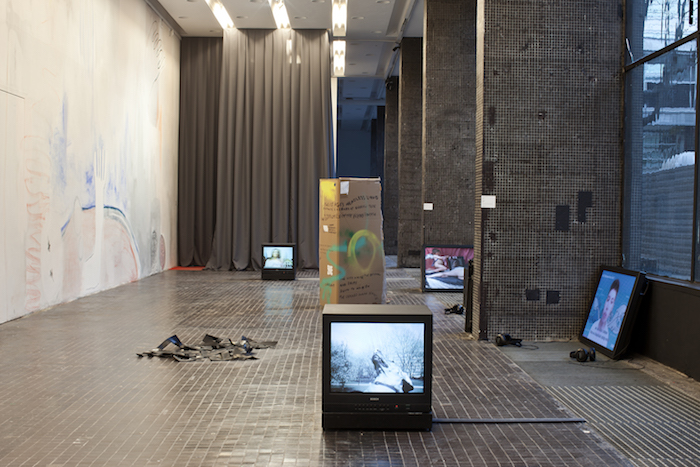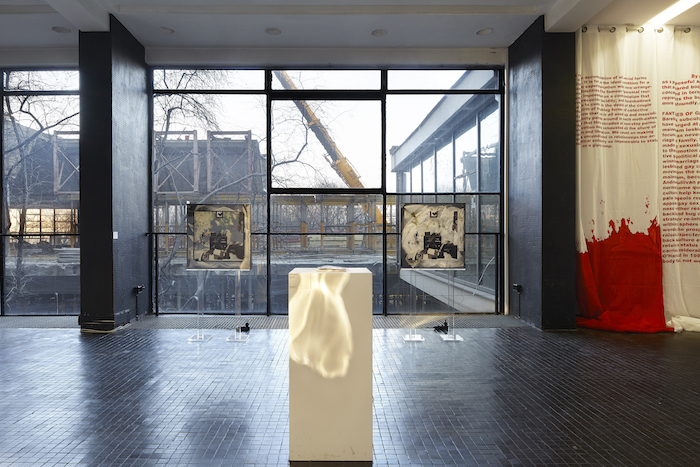“Love is the theory and shame is the practice,” intones Hannah Black’s voice over the backing track of Rihanna’s “What’s My Name.” Spinning, disembodied white limbs, painted nails, and stilettos sprouting from their ends in Black’s 2013 video, Intensive Care/Hot New Track, showing as part of Ministry of Internal Affairs. Intimacy as Text at the Museum of Modern Art Warsaw. A sudden shift to pan over a still of a medicinally-green operating theatre and Riri’s voice intimately blurts out thoughts on her own notoriety: “It happened overnight and I…I…couldn’t control that.” In the show, ideas surrounding theory, confession, and personal identity are harnessed to create a poetry all their own.
Ministry of Internal Affairs, on view until April 2, 2017, showcases a variety of artists whose work draws personal narrative threads into a larger tapestry. “Art discourse has always favoured the cult of individuality and charismatic artistic personas,” says the show’s curator, Natalia Sielewicz. “In my curatorial work on the show I was interested in probing an uncertain territory—whether it is possible to rehabilitate first-person narrative and private experience as tools of transgression and universal knowledge that transform the singular experience into collective manifestation of visibility.”
Videos by VICE

Ministry of Internal Affairs, Museum of Modern Art, Warsaw. Photo by Franciszek Buchner. Courtesy Museum of Modern Art Warsaw.
The show makes its point through a variety of media—but particularly video, such as Caspar Heinemann’s 2015 Fragment, where the artist uses Apple’s Photobooth custom background option to place themself in front of a diagram of an octopus mating, as they describe a disagreement in a Wetherspoons pub over a stranger demanding to know their gender. Intensely personal and yet tossed away with a tender sincerity, the piece highlights the intimate connection that personal narratives can create, and how they intersect with society’s ideas for us. “’I think of the first person as a technology to access something collective: ‘I’ as a contingent node rather than an indication of a stable subject position,” said Heinemann. “I’m obsessed with the responsibility of constantly trying to metabolize reality whilst recognising that every reaction and response changes the conditions to be processed.”

Ministry of Internal Affairs, Museum of Modern Art, Warsaw. Photo by Bartosz Stawiarski. Courtesy Museum of Modern Art Warsaw.
Sielewicz links this particularly to marginalized artists, whose first-person works form the majority of the exhibition: “The art and the world today need strong manifestations of solidarity and courage in relation to the most pertinent issues that we have to deal with today: class inequality, social exclusion, marginalization of LGBT people and people of color, austerity, and xenophobia. First-person accounts have often a transformatory power.”
For example, in Black’s Rihanna-featuring video, the viewer is confronted with elements of colonial uses of bodies, such as diagrams of people packed into a boat like corn on a cob, alongside descriptions from a female prison officer describing the degrading treatment of prisoners at Abu Ghraib. These elements’ framing within the intensely personal narratives makes a statement about our own involvement in stories that can feel historically or experientially remote from our own.

Ministry of Internal Affairs, Museum of Modern Art, Warsaw. Photo by Bartosz Stawiarski. Courtesy Museum of Modern Art Warsaw.
Elsewhere in the show, Jaakko Pallasvuo’s Easy Rider comic depicts the artist as a depressed artist, privileged but struggling, as he falls into a fantastical world where a kind of pagan, ecological magic is pitted against the police force, linking the artist’s personal ennui with the concept of the anthropocene. Meanwhile, Amalia Ulman’s 2015 video, The Annals of Private History, lifts audio sections from YouTubers’ first vlogs, where they begin by introducing themselves. Inspired by the artist’s visit to North Korea, the video is a Clipart-filled trip through the memoirist tradition, Ulman occasionally becoming an authoritarian “Simon Says” figure, ordering her audience to step in tune with her directions.

Ministry of Internal Affairs, Museum of Modern Art, Warsaw. Photo by Franciszek Buchner/Bartosz Stawiarski. Courtesy Museum of Modern Art Warsaw.
Upstairs, pages of Chris Kraus’s novel I Love Dick are plastered in a small red room in Polish—an excellent spatial representation of the space the book takes up in discourse—bright and secretive, obvious and secluded. On the same floor, the curtains of Lily Reynaud Dewar’s 2015 work My Epidemic (Teaching Bjarne Melgaard’s Class), are just as scarlet, printing the text of Melgaard’s lecture on radical feminist theory and AIDS patient testimonials bloody bright. An accompanying video shows this hue covering the artist’s body, as she frolics and reads theoretical art texts like some kind of naked fawn. The paint itself becomes the epidemic.

Ministry of Internal Affairs, Museum of Modern Art, Warsaw. Photo by Franciszek Buchner. Courtesy Museum of Modern Art Warsaw.
As all of us, from your Mum to POTUS, continue to diarize more and more in public spaces, our creation of narratives is becoming mainstream, collective. This show considers the contemporary lens of the personal narrative, and how it intersects with those surrounding us.
Ministry of Internal Affairs. Intimacy as Text is on view at Museum of Modern Art in Warsaw through April 2, 2017.
Related:
Get Personal with Photos from a Performance Art Show About Intimacy
The Master Of Coded Language And Deceiving Text Gets A Retrospective
Send Karen Finley a NSFW Text and She’ll Send You a Personalised Painting




